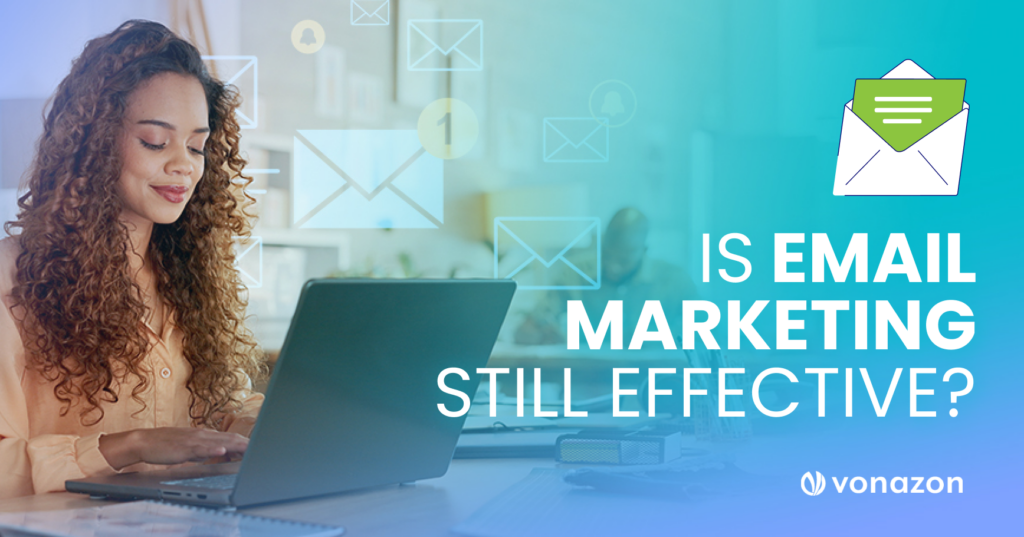Is Email Marketing Still Effective?
Somewhere along the line, email marketing got a bad rap. The rise of social media, chatbots, and AI influencers made it seem old-fashioned – like fax machines or calling someone without texting first. And yet, here we are in 2025, still asking: Is email marketing still effective? The short answer is that it’s not just effective, it’s indispensable.

Email marketing delivers an average ROI of $36 for every $1 spent.


4.48 billion people worldwide are email users.
The real question isn’t whether email marketing is still effective, it’s whether your brand can afford to ignore it.
Let’s dig into why email marketing remains the heavyweight champ and how you can tighten up your game in a crowded inbox arena.
Why Email Marketing Still Works
For all the shiny new platforms, email stands tall because it’s the most direct, personal line to your audience. Social posts can get buried. Ads can get blocked. Algorithms seem to change their minds every other day. But a good email lands directly in the inbox, waiting patiently.
More importantly, it’s owned media. You’re not renting an audience from Facebook or TikTok. When you collect emails for marketing, you’re building a database you control and isn’t subject to sudden algorithm mood swings or platform implosions.
The secret sauce is relevance. The days of spray-and-pray email blasts are over. Today’s effective email marketing feels more like a one-on-one conversation and less like yelling into a crowded bar.
How to Collect Emails for Marketing
Nobody’s jumping at the chance to “subscribe for updates” anymore – and honestly, can you blame them? In a world where inboxes are already bloated with alerts, receipts, and newsletters you swear you never signed up for, brands need to offer something far more compelling than vague updates. If you want to build an email list that engages, you have to earn your spot in someone’s inbox with something that feels valuable, exclusive, or, at the very least, interesting.
A strong lead magnet is still one of the most effective ways to do this, but only if it’s worth downloading. Think useful checklists, actionable templates, exclusive discount codes, or original reports packed with insight – anything that provides significant value to your audience.
Of course, it’s not just about what you offer, but also how you offer it. Website popups, while easy to abuse, can still work incredibly well if timed correctly. Instead of interrupting users the second they arrive, consider using scroll-triggered modals or exit-intent popups that catch attention without sparking instant annoyance. Pair that with well-written copy and an eye-catching design, and you’ve got yourself a list-building machine that doesn’t feel like a nuisance.
Another underutilized list-building tool is events. Hosting a virtual workshop, webinar, or even a casual Q&A session gives people a reason to give you their email, especially when access is gated. You build authority, they get something of value, and you walk away with a more engaged list.
And don’t forget: consent isn’t optional. Thanks to privacy laws like GDPR, CCPA, and their growing list of international siblings, collecting emails for marketing now comes with legal strings attached. Make sure you’re clear about what people are signing up for, and always give them the option to opt out. Transparency builds trust and trust is the real currency in any good email strategy.
How to Write a Marketing Email
HubSpot knows that not every team is operating at the same level or with the same budget. That’s why there are multiple HubSpot Sales Hub plans to fit where you are now and where you’re heading.
Subject Lines Are Life or Death:
Your subject line is the gatekeeper to everything else. If it doesn’t catch attention, the rest of the email might as well not exist. The best subject lines spark curiosity, promise clear value, or create a sense of urgency, without resorting to clickbait. Trick people once, and they won't open your emails again. Respect your reader's time from the first glance.
Get to the Point:
No one opens a marketing email hoping for a three-act story arc. You have seconds to prove your email is worth their time. Start strong with a bold statement, an offer, or a hook that matters to them. Then keep the momentum by moving straight into how you can help, what’s new, or what they should do next. Make every word earn its place.
Personalization Wins:
Using someone’s first name is a good start, but it’s just the beginning. True personalization means tailoring your message based on behavior, preferences, and where they are in their journey with you. The more relevant your email feels, the less it feels like “marketing” and the more it feels like a recommendation from a trusted source.
One Call-to-Action:
One email, one main goal. If you give people too many options (visit the blog, shop the sale, RSVP to the webinar, follow on Instagram) you can create decision paralysis, and they’ll do nothing at all. Be crystal clear about what you want them to do next, and make the path simple and obvious.
How Often Should You Send Marketing Emails?
There is no universal magic number when it comes to how often you should send marketing emails. The sweet spot depends on your audience, your industry, and the type of content you’re delivering.
Data Offers Good Benchmarks
B2C BRANDS
2–4 emails per month
B2B BRANDS
1–2 emails per month
The real key is consistency. Whether it’s once a week or twice a month,
train your audience to expect you, and deliver quality every time.
A recent study found that 74% of consumers want to hear from their favorite brands via email at least once a week. The trick is staying relevant. If you’re providing real value, your subscribers won’t mind seeing you more often. But if you annoy them with filler, and they’ll unsubscribe faster than you can say “limited-time offer.”

FREE TIP
Watch your engagement metrics like a hawk. If open rates and click-through rates dip when you increase frequency, back off. If they stay steady or improve, you might be onto something worth doubling down on.
How to Check Competitors' Email Marketing Campaigns
Not spying on your competitors’ email marketing is like playing chess blindfolded, you might know the rules, but you have no idea what moves are being made across the board. You’re missing key insights into their timing, tone, offers, and audience engagement strategies. This is all intel that could help you position your own campaigns more effectively, avoid copycat pitfalls, and even outmaneuver them in the inbox.
Here’s how to check competitors' email marketing campaigns without feeling like you need a trench coat and fake mustache:
Sign Up for Their Newsletters:
The easiest way to study a competitor’s email strategy is to subscribe like a customer. Use a personal or work email address and archive what they send. Over time, you’ll spot patterns: their timing, tone, offers, design styles, and how they position themselves. Look critically for where they are falling short and in what areas. Are their emails overly salesy? Do they lack educational value? These observations tell you where you can differentiate and improve.

Use Competitive Intelligence Tools:
Platforms like Mailcharts and Similarweb give you access to competitor email archives without waiting for each campaign to hit your inbox. You can review subject lines, sending frequency, promotional trends, and even seasonal strategies. Use this data not to imitate but to inform. Maybe your competitors are sending during crowded times when inboxes are saturated, and you can shift your timing to stand out.

Analyze Their Website and Social Promotions:
Often, brands reveal a lot through their public channels. Watch for email opt-in forms, gated content offers, or “subscriber-exclusive” teasers on their website and social media. This gives you a window into what value they’re promising and whether they’re delivering something you could offer better, faster, or more creatively. Every clue helps you find space to make your own email marketing sharper and more competitive.

The Future of Email Marketing
If you think email is dying, you’re thinking too small. AI, personalization engines, and new tech integrations are actually making email more powerful, not hurting it.
Hyper-personalized emails based on behavioral triggers, predictive content recommendations, dynamic pricing offers are happening as I type this. Brands using AI-driven personalization saw a 41% increase in email revenue in 2024 compared to those who didn’t.
Far from fading away, email marketing is evolving into a smarter, sharper tool. The brands who understand this and invest in cutting edge strategies will dominate inboxes for years to come.
Email Marketing Is as Effective as Ever
Let’s close the case file: yes, email marketing is still wildly effective. Maybe even more so now than ever, precisely because it requires craft and strategy instead of brute force. It’s how you reach customers when social algorithms collapse. It’s how you nurture leads when ads grow too expensive. It’s how you build a real relationship in an era flooded with noise.
At Vonazon, we help brands master the art and science of email marketing, from crafting irresistible emails to building smarter automation that converts. If you’re ready to make your email strategy a growth machine we’re ready to help. Reach out to us today.







